Chapter 8. PLANT DIVERSITY AND LIFE CYCLES
I. OVERVIEW OF PLANT DIVERSITY
Last week we examined some of the diversity of prokaryotes and Protista. This week we will focus on the eukaryotes that photosynthesize and form the Plantae, or the plant clade. This clade includes all of the terrestrial plants but also includes groups of algae, with which they share important characteristics. We will take a comparative approach and look at characteristics that define the major groups of plants and also the characters that help us to know they are all related. The second half of the lab will focus on characteristics that allowed plants to flourish on land.
This comparative approach will focus on morphology, life cycles, and reproduction. Plants and members of the plant clade often combine sexual reproduction with asexual reproduction in interesting ways. Recall how sexual reproduction is important for recombination and creating variation on which natural selection can act. This in turn is a key piece in the evolution of a wide variety of forms!
Members of the plant clade are autotrophic and photosynthetic. Last semester we studied the process of photosynthesis. You recall that photosynthesis happens in the chloroplasts. One important character that unites the plant clade are the chloroplasts and the ability to photosynthesize. Pigments are necessary for capturing light energy, and the kinds of pigments that are present in different groups within the plants help us to understand some of their evolution. Chloroplasts have their own DNA, and there have been extensive studies sequencing the DNA and comparing that DNA between different groups. There is good evidence that chloroplasts evolved through endosymbiosis and that their ancestors were a type of cyanobacteria. The ancestors of terrestrial plants evolved in water and significant changes were necessary for plants to live on land.
In general in this chapter, the term “plant clade” will include all members of the clade. When we use the term “plant,” we will be referring to multicellular terrestrial plants.
A useful way to understand diversity in plants is to compare their life cycles. The life cycle is called an alternation of generations, because, unlike animals, many plants spend a significant portion of their lives in a haploid form and a portion in a diploid form. (In animals, the only stage that is haploid are the eggs and the sperm.)
A generalized depiction of the alternation of generations is shown in Fig. 8.1. We will refer back to this diagram as we consider a variety of plants. In this generialized life cycle, part of the life cycle the plant is haploid (top part of diagram) and part is diploid. Both stages generally are multicellular. The gametophyte (which is haploid) produces gametes by mitosis. Note that this is different from how animals produce gametes! The sporophyte stage produes spores.

RED ALGAE AND GREEN ALGAE
The clade that includes the Red algae, green algae, and land plants is enormous and enormously diverse (Fig. 8.2). These seemly different organisms are grouped together because of the similarity of the sequences in their RNA, the presence of chloroplasts in their cells, and the pigments they use in photosynthesis, especially chlorophyll a (in addition to other pigments).
The red algae (example in Fig. 8.2) are mostly marine and, like the brown algae, are often multicellular and macroscopic. They are the source of carrageenan, a stabilizing agent for a variety of foods and other products. One groups is known as the coralline algae. This group incorporates calcium carbonate in their cell walls and are important in coral reefs. They have a large number of cholorplasts and in addtion to chlorophyll a, they have phycoerythrin, a pigment that gives them their color.
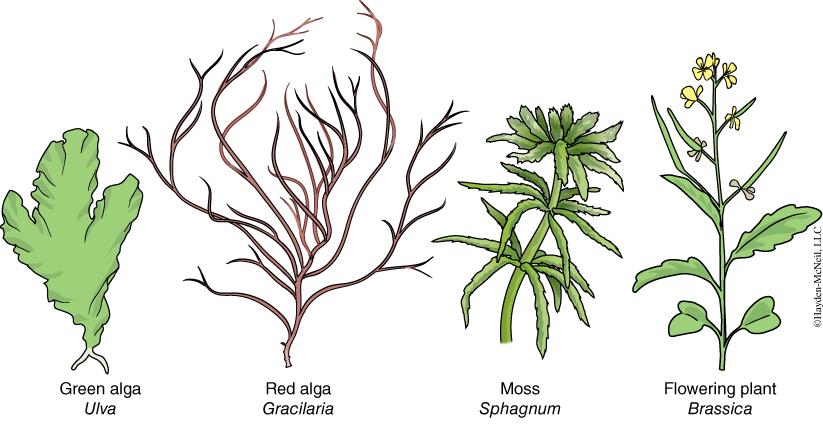
One major clade or group of green algae are the chlorophytes. These include many marine species and many freshwater species, and where there is moisture, they can be terrestrial as well. This group shows impressive diversity in body form, varying from single cells to organisms that are multicellular sheets (as in the sea lettuce), and can be filamentous (as with Spirogyra), solitary (as with the Chlamydomonas), or colonial, as is seen in the Volvox (Fig. 8.3). When they occur in large numbers, even microscopic green algae can be visible macroscopically. Their pigments are chlorophylls a and b, they store starch (a way to store energy) in their chloroplasts, and they have cellulose in their cell walls.
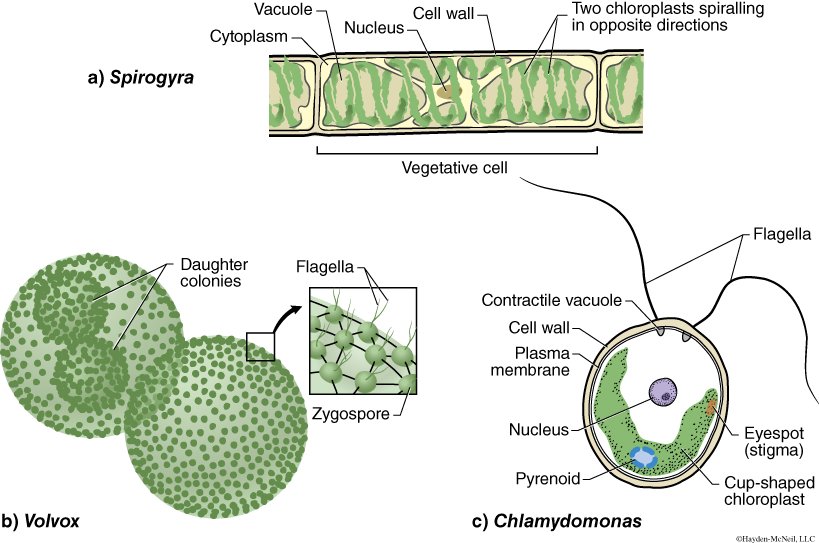
One example of a marine multicellular alga that we will look at with Ulva, or the sea lettuce. It can be large but has very thin blade, and moves easily in the shallow water where it is found. It has a life history that involves alternation of generations and has a diploid phase and a haploid phase (Fig. 8.4). The water in which it lives provides its support.

PROCEDURE PART I
A table can work together in making these slides. Make a wet mount of the solitary alga Chlamydomonas and look for the central nucleus, eye spot, and flagellum. Make a wet mount of the Spirogyra and sketch the filamentous form and the spiral chloroplast. Can you see the nucleus? Next, examine the colonial Volvox. Note if there are daughter colonies. What do these have in common? Make sketches of each. Start your comparison table of characteristics.
Finally, review and know the life cycle of the sea lettuce, as it will be an important point of comparison when we continue the plant clade in a later lab. Make a slide from the blade.
LAND PLANTS
Where did land plants come from and how did they evolve? Characteristics that plants share with the red and green algae provide insights into this question. Land plants use chlorophylls a and b in photosynthesis. In addition, they use starch as a way to store the products of photosynthesis. And, they have cellulose in their cell walls. Compare these traits with the green algae.
Terrestrial adaptations include a variety of characters that keep plants from drying out, provide supportive structures, and package the developing offspring in way that would protect it.
Many plants have a cuticle, a waxy outer covering that protects them from desiccation. Pores in the cuticle are called stomata, and these provide opening for the exchanges of gases. As you know, plant cells have a cell wall that helps to provide some structure. Additional structure comes from lignin and secondary growth. Some plants have vascular tissue in the form of xylem and phloem, structures that help to transport water and minerals as well as the products of photosynthesis. Reproduction often includes both spores and seeds. Gametangia and sporangia are multicellular structures that protect gametes and spores.
A generalized phylogeny of plants is shown in Fig. 8.5.
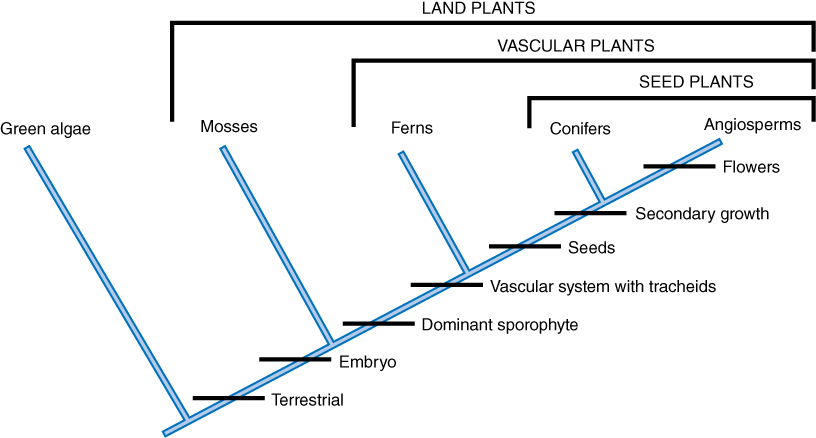
Nonvascular Seedless Plants
The best known of the nonvascular seedless plants are the mosses. However, there are other phyla within this group that share the important characteristic. We will use mosses (Phylum Bryophyta) as our primary example of this group. They have chloroplasts, photosynthesize with chlorophylls a and b, store starch, and have cellulose in their cell walls.
Mosses are terrestrial, known to be small and highly dependent on water. They flourish in areas that have high continual moisture. The green thalli (or small leaves) are the best known part of the life cycle; these stems are the gametophytes. In mosses, the gametophyte generation is the dominant generation. In addition, since this group lacks vascular tissue, it must rely on diffusion to get moisture and minerals to its cells, this in turn severely limits the size of any one thallus of moss. You recall that the gametophyte produces the gametes by mitosis. In many moss species there are separate sexes and the male gametophyte, called the antheridium, produces the sperm while the female gametophyte (the archegonium) produces an egg. We will look at both of these structures. The differences are microscope and are often difficult to detect without a microscope. Fig. 8.6 shows what these structures look like. The entire life cycle is shown in Fig. 8.7.
So how does fertilization take place in a moss? The sperm are flagellated, but the only way a sperm can get to an egg is if water in the form of a raindrop carries it there. Once it is close to the archegonium, the flagella help the sperm to get to the egg. Thus, fertilization is another way that mosses are dependent on water. Once fertilization takes place and a diploid zygote is formed, that zygote undergoes mitosis and grows into a stalk-like structure that has a capsule. This portion of the plant is called the sporophyte and grows out of the female gametophyte (Figs. 8.6 and 8.7). Cells in the capsule undergo meiosis and the resulting haploid cells become spores. When the capsule dries, the tiny spores are released. They can be carried by wind and if they land in a moist area, they grow into a new gametophyte.
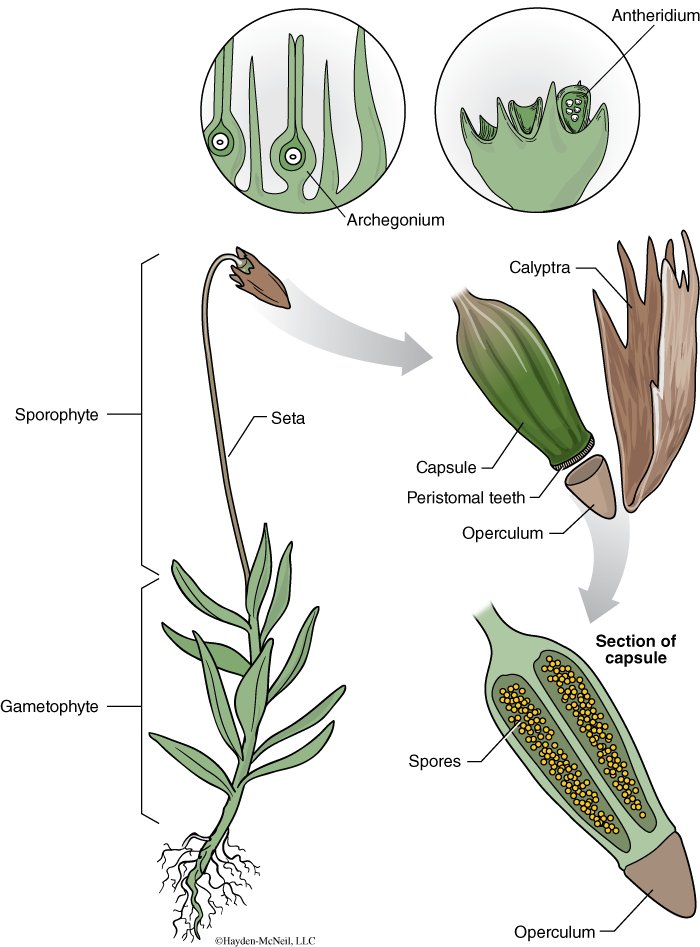
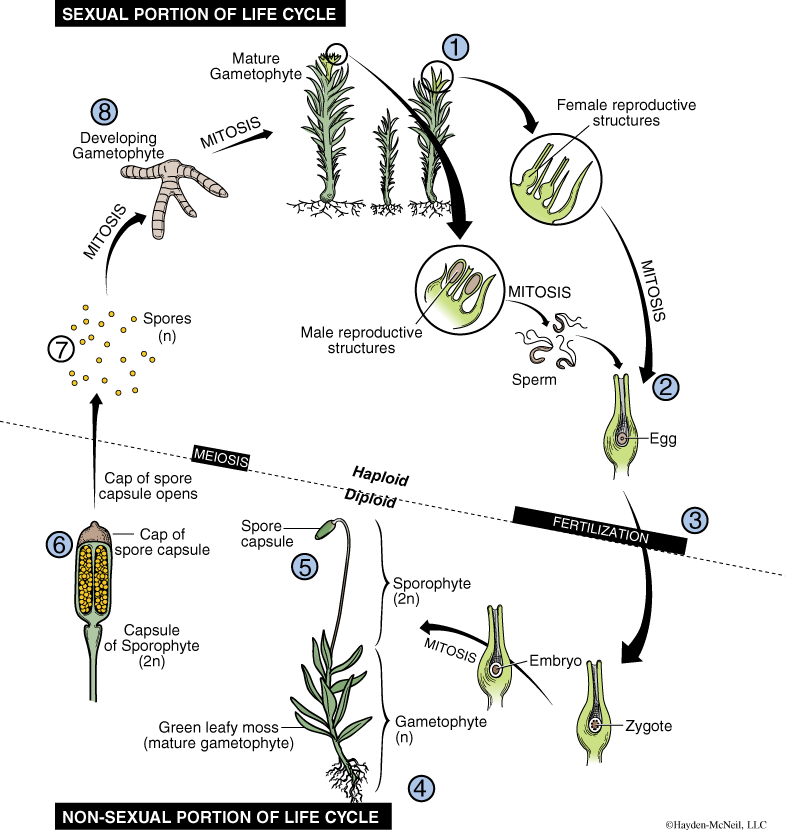
Seedless Vascular Plants
The next group we will examine in detail are the plants that have vascular tissue but don’t have seeds. The seedless vascular plants include the ferns and their allies. Ferns (Phylum Psilophyta) will be our primary example. Alternation of generations also characterizes the seedless vascular plants; however, we start to see a domination of the sporophyte generation. In fact, a general trend that we will see is a reduction in the size and complexity of the gametophyte generation. They have chloroplasts, photosynthesize with chlorophylls a and b, store starch, and have cellulose in their cell walls. Ferns are our first group that has vascular tissue, an important tissue that transports material from one part of a plant to another part. Vascular tissue is necessary if a plant is going to be bigger than a moss. The vascular tissue, especially a tracheid (a specialized cell), has a rigid enough cell wall to also provide support. The tracheid is found in all vascular plants.
In the seedless vascular plants, the sporophyte generation is the most conspicuous part of the life cycle. They require water for the sperm to reach the nonmotile egg. The development of a spore that was resistant to desiccation was a key step in moving onto land.
Examine the life cycle of the fern (Fig. 8.8) and find the sporophyte. Spores are typically produced on the underside of the fonts or leaves in a structure called a sorus. A sorus is a cluster of sporangia, a structure in which the spores are formed by meiosis. As with the moss, the spores are then haploid. When the sorus dries it will burst open, spreading the spores. If a microscopic spore is lucky and lands on a moist or wet substrate, it grows by mitosis into the gametophyte stage. In ferns, the gametophyte is never large and when it is mature, it is a heart-shaped structure called a prothallus (Fig. 8.9) with rhizoid or small roots attached to it. The archegonia and antheridia typically grow on the underside of the prothallus. Fertilization takes place when a sperm from a nearby antheridium swims to an archegonium and fertilizes an egg. The resulting zygote is now diploid and grows by mitosis and becomes the part of the fern that most people recognize (Fig. 8.9).


PROCEDURE: MOSS AND FERNS
Examine the moss gametophyte and sporophyte on the side table. Be able to recognize each. Examine and sketch the antheridium and archegonium from the prepared slides. Examine and sketch the capsule. Look at the spores and estimate their size. Before you move to the next part of the exercise, you should be able to draw and label the life cycle of a moss.
Examine the ferns and look for examples of sporophytes (with sori). We will have fern gametophytes as well. You should know the life cycle of a fern. How are ferns dependent on water? Look at fern spores.
Continue to make your comparative table.
Vascular Seed Plants: Gymnosperms and Angiosperms
The vascular seed plants include two very large groups: the gymnosperms and the angiosperms. These largest and most widespread of the plants use seeds as their primary means of reproduction and dispersal. They have chloroplasts, photosynthesize with chlorophylls a and b, store starch, and have cellulose in their cell walls. Seeds are an important adaptation of terrestrial life, and we will examine some in detail. A seed is an embryonic sporophyte that is packaged with nutritious material and surrounded by a seed coat. Many seeds can withstand long periods of being dry or cold and still be able to germinate. Clearly, seeds were a crticially important evolutionary development. And because they are a storage place for food for plant embryo, many animals, including humans, have used seeds as an important source of food. What are some examples of seeds that we often use for food?
Gymnosperms
Gymnosperms include four phyla of very interesting plants, including cycads and ginkoes. However, we will primarily focus on conifers. Conifers include pines and firs and are probably those most familiar to us. Most have needles—long, thin leaves that are tough and have a thick cuticle. Most are evergreen and keep their needles throughout the year.
In the life cycle of the pine, the sporophyte is dominant (Fig. 8.10). Thus the trees that we are familiar with are the sporophytes. We will compare male cones and female cones from local pines. The male cone produces microspores, which become the male gametophyte. The female cone produces megaspores, which become the female gametophyte. The gametophytes produce the gametes. The male gametophyte produces pollen, which will grow down to meet the female gametophyte. The sperm produced by the pollen will fuse with the ovule in the female gametophyte and a zygote will grow to a small embryo, which will beome the pine seed. The seeds of the pine take three years to mature and are on the scales of the female pine cone.

Angiosperms
The angiosperms or flowering plants are the most successful group of plants in terms of numbers of species. They show a stunning diversity and are found in almost every terrestrial environment. Some have very conspicuous and large flowers, while others (like the grasses) have very small flowers. Flowers have a unique double fertilization and, unlike the gymnosperms, seeds are produced within fruits that protect the seeds and help with their dispersal.
The flowers of flowering plants are the reproductive structures and there is enormous variety in the hundreds of thousands of species of flowers (Fig. 8.11). There are some species in which male and female flowers are on the same plant, and some in which they are on separate plants. Some disperse their pollen by wind, others disperse their pollen by bees, flies, beetles, birds, or even bats.
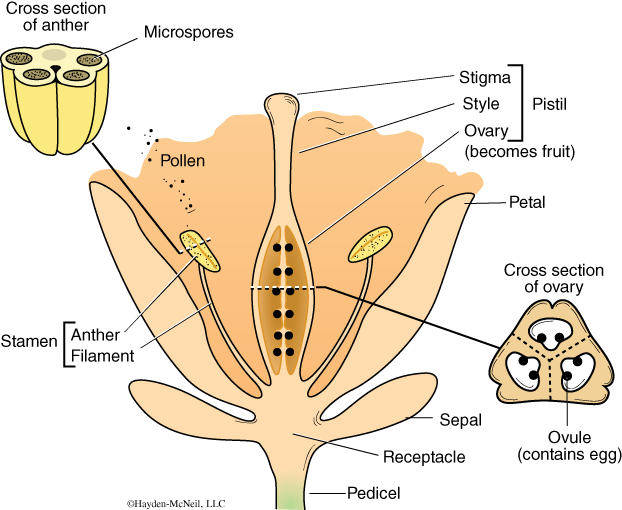

PROCEDURE: GYMNOSPERMS AND ANGIOSPERMS
Gymnosperms: Examine the pine limbs. Compare and be able to identify the male cones and female cones. Sketch several of the pine seeds.
What is the difference between a gymnosperm seed and an angiosperm seed?
Working in groups of 2 or 3, dissect a flower and find the parts labeled on Fig. 8.11. What is a fruit?
Complete your comparative table (outline provided at the end of this chapter).
II. PLANT STRUCTURES
Roots
Stems
Leaves
In the second half of this lab, we will look at angiosperm structures in more detail, particuarly with an eye to know more about the characteristics that allow these plants to flourish on land. We will example seeds, roots, stems, and leaves.
SEEDS
In angiosperms, a seed is the product of the process known as double fertilization. Two sperm cells from the male gametophyte, the pollen grain, enter the ovary via the fertilizaiton tube that grows from the pollen grain. One of the sperm fertilizes an ovule, forming a diploid zygote; the other sperm fuses with two haploid nuclei from a central cell, forming the triploid endosperm. The zygote develops into the young plant embryo and develops using the endosperm as a source of nutrition. The ovary, which surrounds the ovule, develops into the fruit. The cotyledons (or seed leaves) absorb the endosperm and in turn provide nutrients for the developing plant. Both seeds and fruits can be highly nutritious.
The seed, then, is a “package” that includes the young plant embryo (at an arrested stage of development) as well as nutrients that are there for the developing embryo. In addition, seeds also have a protective seed coat, which helps to protect the seed from desiccation or drying out. In some cases, before germination can take place, the seed coat must be roughened or broken, which can happen, for example, when the seed passes through the gut of a bird. Germination is the resumption of growth in the sprouting of a seed. Seeds allow plants to delay their reproduction until conditions are suitable for growth. In fact, the seeds cannot germinate or grow at all until the conditions are suitable. How did the evolution of seeds help angiosperms to thrive and diversify?
The parts of a seed are clearly seen in a bean (Fig. 8.13). The bulk of the seed are the two cotyledons. The radicle is the embryonic root; the plumule is the embryonic shoot with primary leaves. The hypocotyl is the part of the stem below the attachment to the cotyledons. The seed coat covers all of these. In another example, the corn kernel, there is a single cotyledon (Fig. 8.13). The bulk of the seed or kernel is the endosperm, but if the seed is cut longitudinally, you can see the plumule as well as the radicle. Seeds are important for dispersal and Fig. 8.14 shows a variety of kinds of seeds.
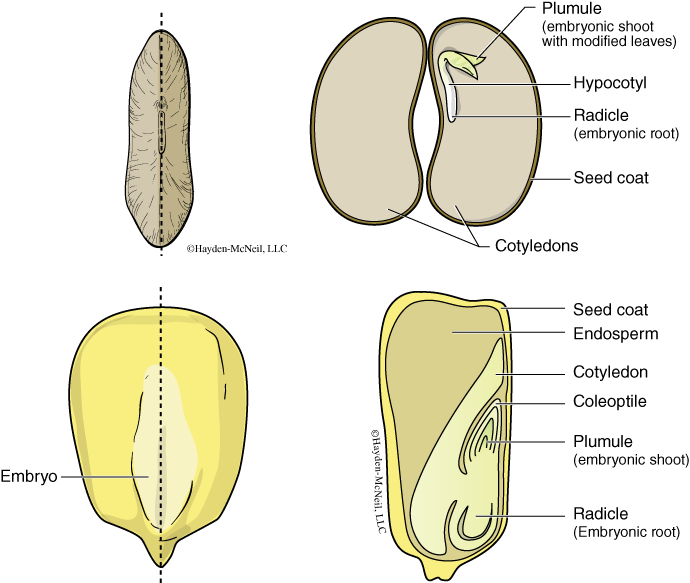
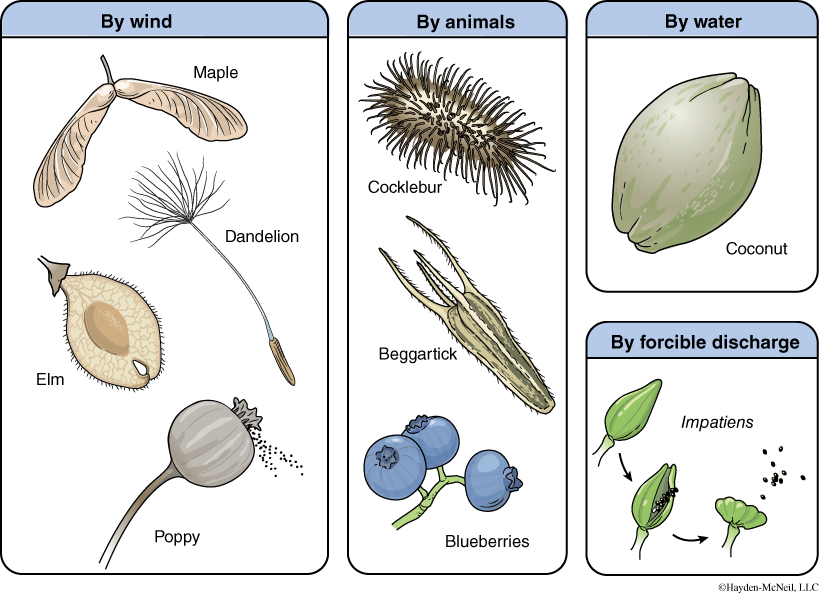
The Structure of a Mature Plant
A mature plant is generally comprised of a root system and a stem system. Each system lives in a vastly different environment: roots generally live in sometimes moist soils, while stems are in relatively dry air. The roots provide an anchor for the plant, and the strength of this anchor is demonstrated by how much energy is required to pull a large plant from the ground. The stem system is comprised of the stems and the leaves, and in general, the stem holds up the leaves, which in turn provide a wide, flat surface exposed to the sun for photosynthesis. It is mostly in the leaves that the light energy is absorbed and photosynthesis takes place. A diagram of a mature plant is provided in Fig. 8.15. The root system consists of a primary root and lateral roots, and in many cases, in very small root hairs. Leaves, stems, and roots are vegetative structures; reproductive structures are the flowers and the fruit.
There are three tissue systems that make up plants. Most of the plant body is comprised of the ground tissue system. The vascular tissue system helps provide support and conducts critical water and minerals and also transports the products of photosynthesis. Finally, the dermal tissue system provides the outer covering of the plant.
Roots, stems, and leaves are organs, as they are made from different tissues. These organs each have special functions, but they are all connected. The vascular system is comprised of xylem and phloem. Xylem conducts water and dissolved minerals from the roots to the rest of the plant. Phloem conducts food material, the products of photosynthesis, to the stems and the roots. One particularly important type of cell in the vascular tissue is the tracheid. These are elongated cells in the xylem that transport water and salts. In addition, they are tough and help give the plant rigidity and structure. Compare this with algae living in water that provides support. The evolution of the tracheid about 430 million years ago was one of the key events that allowed subsequent diversification.
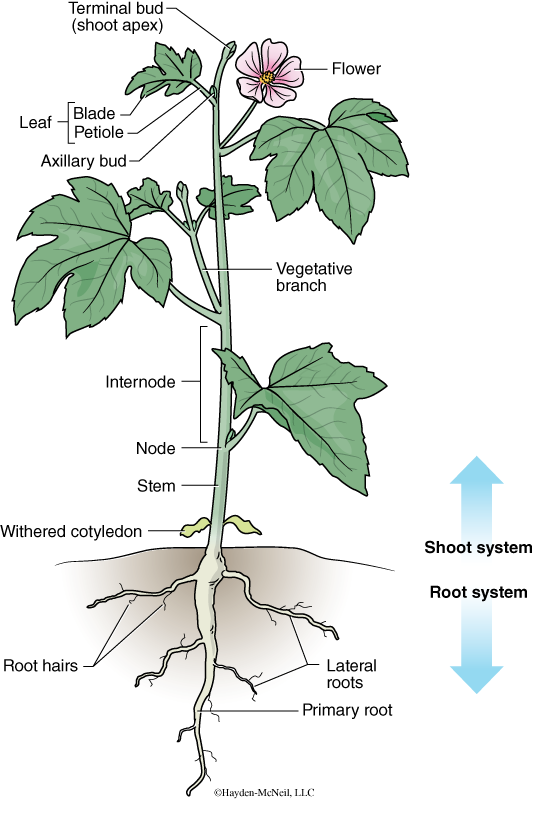
ROOTS
Roots are impressive structures. The ability to take moisture and nutrients from the ground, and move that material to where the plant needs it, is nothing less than stunning. The structure of roots reflect their function; roots have several ways to increase their surface area, including using root hairs and microriiza, or symbiotic fungi, to increase surface area.
As a biology student, you have already examined roots a couple of times in the first semester of the majors biology class. The root tip of onions is often used for studying mitosis, as the cells near the tip of the root are growing nearly continuously and so it is possible to see some of the different stages of mitosis. Fig. 8.16 shows the different regions of a sample root.
Roots can take a variety of forms and the size of the root is a function of the size of the plant. In trees, for example, the amount of growth that is underground in the root is as much as is visible above ground. The common types of roots include fibrous roots (as is seen in grasses), tap roots (as in shrubs), modified tap roots (as in carrots; the roots are modified as a way to store energy), and aerial roots, such as is seen in many orchids. In addition, some roots are specialized for holding a plant up, as is seen in corn. These are called prop roots.
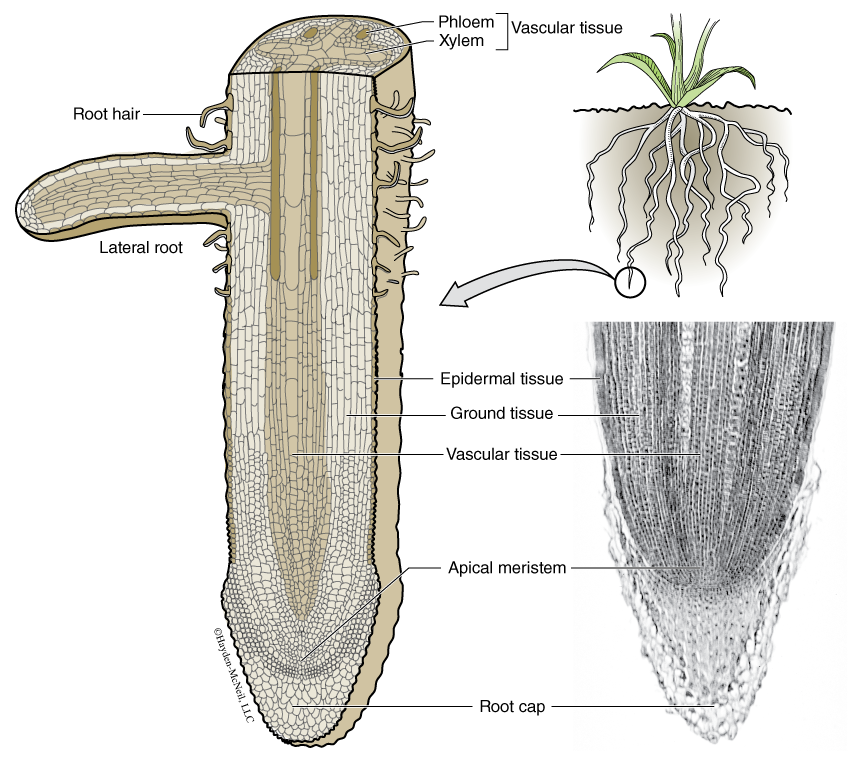
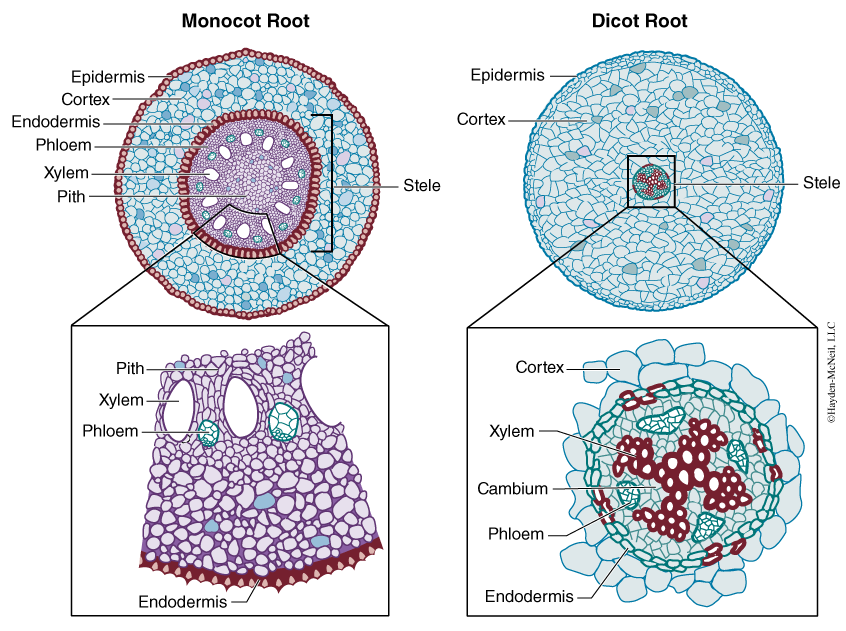
When you look at a root in cross section, remember that you are looking at the cross section of a cylinder. We we use a dicot as our example. The outermost layer is the protective epidermis (Fig. 8.16, bottom right). Root hairs, or very small extensions of the main root are modifications of the epidermis. Water enters the root hairs and moves along the cell walls (and at this point, does not actually enter the cells). The cellulose in cell walls can absorb a lot of water (much as cotton strands, made mostly of cellulose, can absorb a lot of water). The bulk of the root is the cortex, an area that fills all but the center of the root. It is comprised of thin-celled walls with many intracellular spaces. This is an area that functions in starch storage. The intracellular spaces allows for the uptake of water and also for the movement of oxygen. The inner layer of the cortex is the endodermis, a tight-fitting layer of cells. The center of the root is the stele, or the vascular cylinder. Inside the stele, the xylem elements have branches and often form an “X” shape (which makes it easy to learn and remember!). The phloem, for conducting dissolved sugars, is found between the arms of the xylem. At this point, water that has moved into the root has moved laterally from the root hairs to the cortex and finally into the epidermis. Once the water is at the xylem, it will move up into the stem and leaves.
The vascular tissue in the roots is continuous with the vascular tissue in the stems and leaves.
STEMS
Stems of plants serve several important functions and the function is reflected in their structure. Stems can be found in a variety of forms including the trunks of trees or the 100-foot-long vines of kudzu. Stems provide support for the leaves and reproductive structures, holding the leaves where they can get sun, and holding the flowers where they are either exposed to wind for pollination or to animal pollinators. Stems connect the roots, where water and minerals are taken in, and the leaves where photosynthesis occurs. The vascular system is continuous through these three organs: roots, stems, and leaves.
Stems are also the source of new tissue and new growth for the plant. Primary growth in plants is the elongation of a plant that occurs in both at the tips of the roots and the tips of the stems. Secondary growth is the increase in the girth of a plant and is seen only in some dicots (such as trees). Secondary tissues are wood and bark.
In some cases, stems can be important storage units for both plants and people. For example, the Irish potato is a modified underground stem and has been an important source of food for Andean Indians for centuries, and an important source of food for Europeans and Americans for the last 200 hundred years.
We will use a dicot as our primary example. First, there is a protective outer layer, the epidermis. It includes a waxy layer, the cuticle, the helps to protect the plant from desiccation. The bulk of the inner portion of the stem (Fig. 8.17, bottom portion of figure) is called the pith and is the ground tissue system. It is comprised of large, thin walled cells. Around the outer third of the cross section of a eudicots stem, there is a series of vascular bundles. Each vascular bundle looks a bit like an acorn, and has xylem (found toward the inside) and phloem (toward the outside). Some species also have a phloem cap found on the outside of the phloem. Also in some species there is a type of tissue between the xylem and phloem called the vascular cambium.
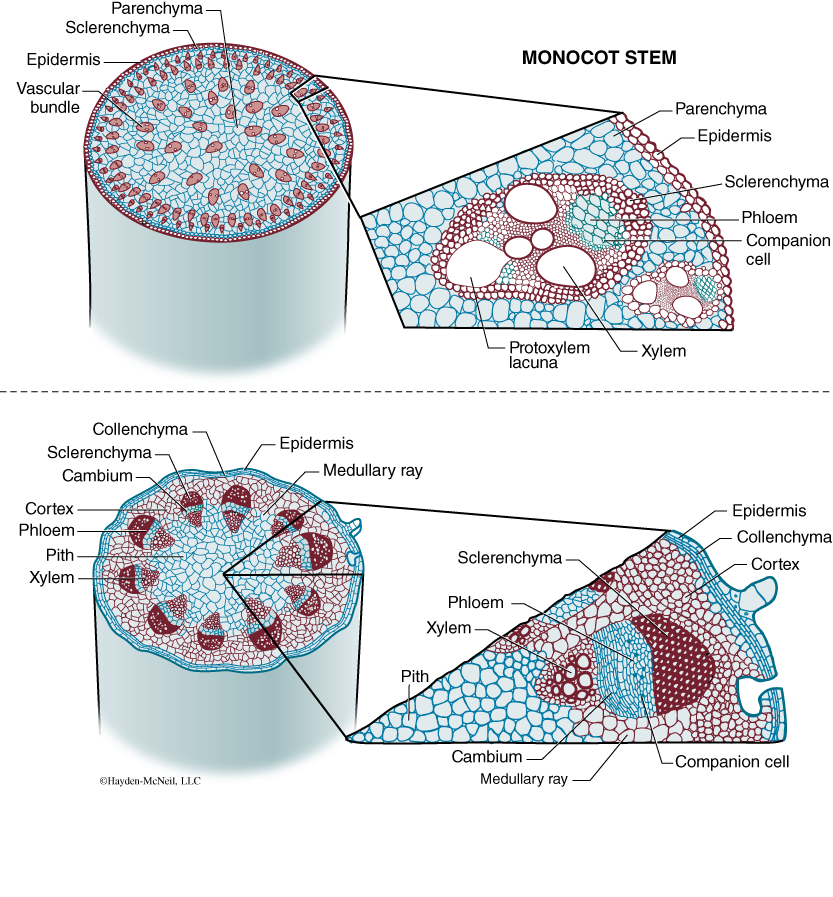
LEAVES
Leaves are modified stems that are flattened and have a concentration of photosyntheic tissues. They have vascular tissue in the form of vascular bundles (the veins) and stomata, openings that allow for some gas exchange. Their shape and orientation maximize surface area for gathering light for photosynthesis. There is an outer epidermal layer. The mesophyll fills the space between the upper and lower epidermis and the mesophyll cells are packed with chloroplasts. Guard cells on either side of a stomata open or close the stomata.
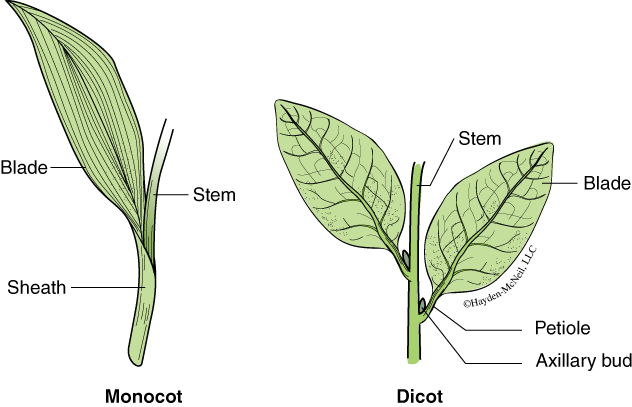
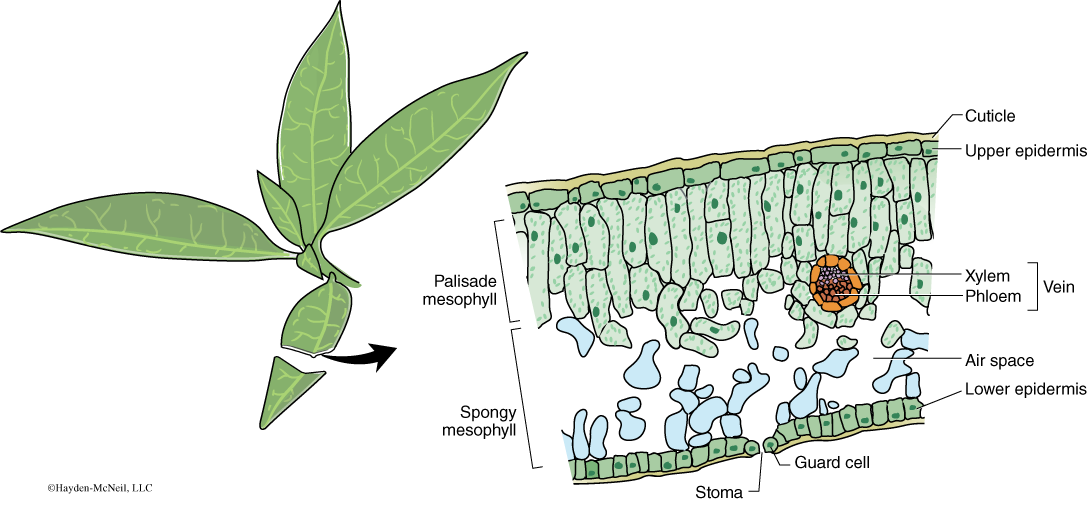
PROCEDURE: SEEDS, ROOTS, STEMS, AND LEAVES
SEEDS
Examine the variety of seeds on the side table. Pick one or two examples and hypothesize about how they could be dispersed. Next, from the side table, get examples of dry seeds and soaked seeds that are germinating or about to germinate. You should get both monocot seeds (corn) and eudicot seeds (beans). Next, examine and sketch each carefully. The soaked seeds will be much easier to open and examine.
ROOTS
We will look first at the longitudinal section of an onion root. We have used these slides to look at mitosis now we will use them to look at the structure of the root. With the onion root, sketch and identify the root cap as well as the actively growing root meristem.
In the root cross sections, identify, sketch, and label the dicot root. In the latter, you should pay particular attention to the vascular tissue (xylem and phloem). Label your sketches and be able to recognize all that you have examined.
STEMS
Sketch the cross section of the dicot stem and be able to identify the vascular bundles, xylem, phloem, bundle sheaths, pith, and epidermis.
LEAVES
Sketch the cross section of the leaf. Note the location of the vascular bundle. Identify the cuticle, epidermis, mesophyll, xylem and phloem, guard cell, and stoma.
In your lab notebook, write a paragraph about the importance of the evolution of chloroplasts, pigments, vascular tissue, tracheids, leaves, stems, and roots.